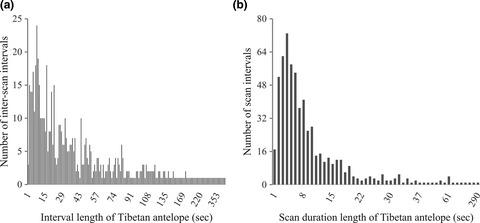Our official English website, www.x-mol.net, welcomes your feedback! (Note: you will need to create a separate account there.)
Unpredictability of vigilance in two sympatric Tibetan ungulates
Ethology ( IF 1.7 ) Pub Date : 2020-05-14 , DOI: 10.1111/eth.13034 Yunchao Luo 1, 2 , Lin Wang 1 , Le Yang 3 , Xinxin Wang 1 , Xingjun Tian 1, 2 , Zhongqiu Li 1, 2
Ethology ( IF 1.7 ) Pub Date : 2020-05-14 , DOI: 10.1111/eth.13034 Yunchao Luo 1, 2 , Lin Wang 1 , Le Yang 3 , Xinxin Wang 1 , Xingjun Tian 1, 2 , Zhongqiu Li 1, 2
Affiliation

|
Vigilance is a state of alertness aimed at detecting predatory or competitive stimuli (Pays, Dubot, Jarman, Loisel, & Goldizen, 2009). The main function of vigilance is anti-predator (Elgar, 1989; Lima, 1987; Roberts, 1996). And it is thought to occur when animals raise their head to scan their surroundings (Beauchamp, 2014). Pulliam first proposed the theory of anti-predator vigilance strategies based on randomness in scanning behavior (Pulliam, 1973). Instantaneous randomness in scan initiation and sequential randomness across scans are two important assumptions of Pulliam model (Bednekoff & Lima, 1998; Hart & Lendrem, 1984; Pulliam, 1973). Instantaneous randomness means that the predator is unable to predict when the prey will scan so that the predator cannot effectively time its attack (Carro & Fernandez, 2009). Consequently, the distribution of inter-scan intervals will follow a negative exponential distribution (Bednekoff & Lima, 1998). This has been found in several species, such as ostriches (Struthio camelus) (Bertram, 1980), yellow-eyed Junco (Junco phaeonotus) (Caraco, 1982), house sparrow (Passer domesticus) (Studd, Montgomerie, & Robertson, 1983), and black-necked Crane (Grus nigricollis) (Li, Yang, Luo, Wu, & Li, 2018). Instantaneous randomness is thought to be effective when facing a stalking predator (Bednekoff & Lima, 2002; Scannell, Roberts, & Lazarus, 2001), because stalking predators such as cat will take advantage of any regularity in prey scanning to advance Received: 17 February 2020 | Revised: 12 April 2020 | Accepted: 13 April 2020 DOI: 10.1111/eth.13034
中文翻译:

两只同域藏有蹄类动物警惕性的不可预测性
警惕是一种警觉状态,旨在检测掠夺性或竞争性刺激(Pays、Dubot、Jarman、Loisel 和 Goldizen,2009 年)。警惕的主要功能是防掠食者(Elgar,1989;Lima,1987;Roberts,1996)。它被认为是在动物抬起头扫描周围环境时发生的(Beauchamp,2014)。Pulliam 首先提出了基于扫描行为随机性的反捕食者警戒策略理论(Pulliam,1973)。扫描开始的瞬时随机性和扫描的顺序随机性是 Pulliam 模型的两个重要假设(Bednekoff & Lima,1998;Hart & Lendrem,1984;Pulliam,1973)。瞬时随机性意味着捕食者无法预测猎物何时进行扫描,因此捕食者无法有效计时(Carro & Fernandez, 2009)。最后,扫描间隔的分布将遵循负指数分布 (Bednekoff & Lima, 1998)。这已在几种物种中发现,例如鸵鸟 (Struthio camelus) (Bertram, 1980)、黄眼 Junco (Junco phaeonotus) (Caraco, 1982)、麻雀 (Passerdomesticus) (Studd, Montgomerie, & Robertson, 1983 ) 和黑颈鹤 (Grus nigricollis) (Li, Yang, Luo, Wu, & Li, 2018)。即时随机性在面对跟踪捕食者时被认为是有效的(Bednekoff 和 Lima,2002 年;Scannell、Roberts 和 Lazarus,2001 年),因为像猫这样的跟踪捕食者会利用猎物扫描中的任何规律性来推进 收到:2 月 17 日2020 | 修订日期:2020 年 4 月 12 日 | 接受:2020 年 4 月 13 日 DOI:10.1111/eth.13034 这已在几种物种中发现,例如鸵鸟 (Struthio camelus) (Bertram, 1980)、黄眼 Junco (Junco phaeonotus) (Caraco, 1982)、麻雀 (Passerdomesticus) (Studd, Montgomerie, & Robertson, 1983 ) 和黑颈鹤 (Grus nigricollis) (Li, Yang, Luo, Wu, & Li, 2018)。即时随机性在面对跟踪捕食者时被认为是有效的(Bednekoff 和 Lima,2002 年;Scannell、Roberts 和 Lazarus,2001 年),因为像猫这样的跟踪捕食者会利用猎物扫描中的任何规律性来推进 收到:2 月 17 日2020 | 修订日期:2020 年 4 月 12 日 | 接受:2020 年 4 月 13 日 DOI:10.1111/eth.13034 这已在几种物种中发现,例如鸵鸟 (Struthio camelus) (Bertram, 1980)、黄眼 Junco (Junco phaeonotus) (Caraco, 1982)、麻雀 (Passerdomesticus) (Studd, Montgomerie, & Robertson, 1983 ) 和黑颈鹤 (Grus nigricollis) (Li, Yang, Luo, Wu, & Li, 2018)。即时随机性在面对跟踪捕食者时被认为是有效的(Bednekoff 和 Lima,2002 年;Scannell、Roberts 和 Lazarus,2001 年),因为像猫这样的跟踪捕食者会利用猎物扫描中的任何规律性来推进 收到:2 月 17 日2020 | 修订日期:2020 年 4 月 12 日 | 接受:2020 年 4 月 13 日 DOI:10.1111/eth.13034 和黑颈鹤 (Grus nigricollis) (Li, Yang, Luo, Wu, & Li, 2018)。即时随机性在面对跟踪捕食者时被认为是有效的(Bednekoff 和 Lima,2002 年;Scannell、Roberts 和 Lazarus,2001 年),因为像猫这样的跟踪捕食者会利用猎物扫描中的任何规律性来推进 收到:2 月 17 日2020 | 修订日期:2020 年 4 月 12 日 | 接受:2020 年 4 月 13 日 DOI:10.1111/eth.13034 和黑颈鹤 (Grus nigricollis) (Li, Yang, Luo, Wu, & Li, 2018)。即时随机性在面对跟踪捕食者时被认为是有效的(Bednekoff 和 Lima,2002 年;Scannell、Roberts 和 Lazarus,2001 年),因为像猫这样的跟踪捕食者会利用猎物扫描中的任何规律性来推进 收到:2 月 17 日2020 | 修订日期:2020 年 4 月 12 日 | 接受:2020 年 4 月 13 日 DOI:10.1111/eth.13034
更新日期:2020-05-14
中文翻译:

两只同域藏有蹄类动物警惕性的不可预测性
警惕是一种警觉状态,旨在检测掠夺性或竞争性刺激(Pays、Dubot、Jarman、Loisel 和 Goldizen,2009 年)。警惕的主要功能是防掠食者(Elgar,1989;Lima,1987;Roberts,1996)。它被认为是在动物抬起头扫描周围环境时发生的(Beauchamp,2014)。Pulliam 首先提出了基于扫描行为随机性的反捕食者警戒策略理论(Pulliam,1973)。扫描开始的瞬时随机性和扫描的顺序随机性是 Pulliam 模型的两个重要假设(Bednekoff & Lima,1998;Hart & Lendrem,1984;Pulliam,1973)。瞬时随机性意味着捕食者无法预测猎物何时进行扫描,因此捕食者无法有效计时(Carro & Fernandez, 2009)。最后,扫描间隔的分布将遵循负指数分布 (Bednekoff & Lima, 1998)。这已在几种物种中发现,例如鸵鸟 (Struthio camelus) (Bertram, 1980)、黄眼 Junco (Junco phaeonotus) (Caraco, 1982)、麻雀 (Passerdomesticus) (Studd, Montgomerie, & Robertson, 1983 ) 和黑颈鹤 (Grus nigricollis) (Li, Yang, Luo, Wu, & Li, 2018)。即时随机性在面对跟踪捕食者时被认为是有效的(Bednekoff 和 Lima,2002 年;Scannell、Roberts 和 Lazarus,2001 年),因为像猫这样的跟踪捕食者会利用猎物扫描中的任何规律性来推进 收到:2 月 17 日2020 | 修订日期:2020 年 4 月 12 日 | 接受:2020 年 4 月 13 日 DOI:10.1111/eth.13034 这已在几种物种中发现,例如鸵鸟 (Struthio camelus) (Bertram, 1980)、黄眼 Junco (Junco phaeonotus) (Caraco, 1982)、麻雀 (Passerdomesticus) (Studd, Montgomerie, & Robertson, 1983 ) 和黑颈鹤 (Grus nigricollis) (Li, Yang, Luo, Wu, & Li, 2018)。即时随机性在面对跟踪捕食者时被认为是有效的(Bednekoff 和 Lima,2002 年;Scannell、Roberts 和 Lazarus,2001 年),因为像猫这样的跟踪捕食者会利用猎物扫描中的任何规律性来推进 收到:2 月 17 日2020 | 修订日期:2020 年 4 月 12 日 | 接受:2020 年 4 月 13 日 DOI:10.1111/eth.13034 这已在几种物种中发现,例如鸵鸟 (Struthio camelus) (Bertram, 1980)、黄眼 Junco (Junco phaeonotus) (Caraco, 1982)、麻雀 (Passerdomesticus) (Studd, Montgomerie, & Robertson, 1983 ) 和黑颈鹤 (Grus nigricollis) (Li, Yang, Luo, Wu, & Li, 2018)。即时随机性在面对跟踪捕食者时被认为是有效的(Bednekoff 和 Lima,2002 年;Scannell、Roberts 和 Lazarus,2001 年),因为像猫这样的跟踪捕食者会利用猎物扫描中的任何规律性来推进 收到:2 月 17 日2020 | 修订日期:2020 年 4 月 12 日 | 接受:2020 年 4 月 13 日 DOI:10.1111/eth.13034 和黑颈鹤 (Grus nigricollis) (Li, Yang, Luo, Wu, & Li, 2018)。即时随机性在面对跟踪捕食者时被认为是有效的(Bednekoff 和 Lima,2002 年;Scannell、Roberts 和 Lazarus,2001 年),因为像猫这样的跟踪捕食者会利用猎物扫描中的任何规律性来推进 收到:2 月 17 日2020 | 修订日期:2020 年 4 月 12 日 | 接受:2020 年 4 月 13 日 DOI:10.1111/eth.13034 和黑颈鹤 (Grus nigricollis) (Li, Yang, Luo, Wu, & Li, 2018)。即时随机性在面对跟踪捕食者时被认为是有效的(Bednekoff 和 Lima,2002 年;Scannell、Roberts 和 Lazarus,2001 年),因为像猫这样的跟踪捕食者会利用猎物扫描中的任何规律性来推进 收到:2 月 17 日2020 | 修订日期:2020 年 4 月 12 日 | 接受:2020 年 4 月 13 日 DOI:10.1111/eth.13034



























 京公网安备 11010802027423号
京公网安备 11010802027423号